 Java
Java
 javaTutorial
javaTutorial
 Principle and example analysis of Java-based distributed service framework Dubbo
Principle and example analysis of Java-based distributed service framework Dubbo
Principle and example analysis of Java-based distributed service framework Dubbo
Preface
Before introducing Dubbo, let’s first understand the basic concepts:
Dubbo is a RPC framework. RPC, that is, Remote Procedure Call (remote procedure call), the opposite is local procedure call. Before the distributed architecture, the single application architecture and vertical application architecture used local Procedure call. It allows a program to call a procedure or function in another address space (usually another machine shared on a network) without the programmer having to explicitly code the details of the remote call.
Remote calls between distributed architecture applications require the RPC framework. The purpose is to make remote calls as simple as local calls.
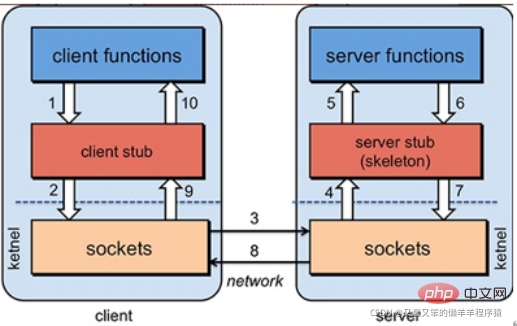
Dubbo framework has the following components
Consumer
That is, the service consumer that calls the remote service. The consumer needs to interface programming, know Which interfaces can be called, the specific implementation requires the framework to provide a proxy class to provide a specific implementation for the interface, so that consumers only need to call which interface, and the acquisition of the specific implementation is handled by the proxy class.
Consumers also need to provide the calling method name and method parameter values.
But the proxy class does not yet know which remote method on the server needs to be called at this time. At this time, a registration center is needed to obtain a list of remote services that can be called.
Remote servers are generally deployed in clusters, so which server to call requires load balancing to select the most appropriate server to call.
At the same time, a cluster fault-tolerant mechanism is also required. Due to various reasons, remote calls may fail. At this time, a fault-tolerant mechanism is needed to retry the call to ensure the stability of the remote call.
At the same time, the communication protocol and serialization format are agreed upon with the service provider to facilitate communication and data transmission.
Provider
That is, the service provider that exposes the service. The service provider implements a specific interface internally, then exposes the interface, and then registers the service in the registration center, and the service consumer calls the service. After the provider receives the call request, it processes the request through the agreed communication protocol, and then deserializes it. After completion, it puts the request into the thread pool for processing. A thread receives the request and finds the corresponding interface implementation. Make a call and then return the result of the call.
Registry
It is the registration center for service registration and discovery. The registration center is responsible for the registration and search of service addresses, which is equivalent to the service directory. Service providers and consumers will only register with each other when starting. Center interaction, the registration center does not forward requests, and the pressure is low.
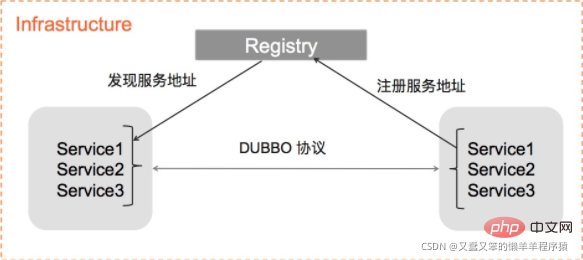
#The registry can also centralize configuration processing and dynamically notify subscribers of changes.
But why do we need a registration center? Isn’t it possible without a registration center?
In the absence of a registration center, the calling relationship between services is as follows:
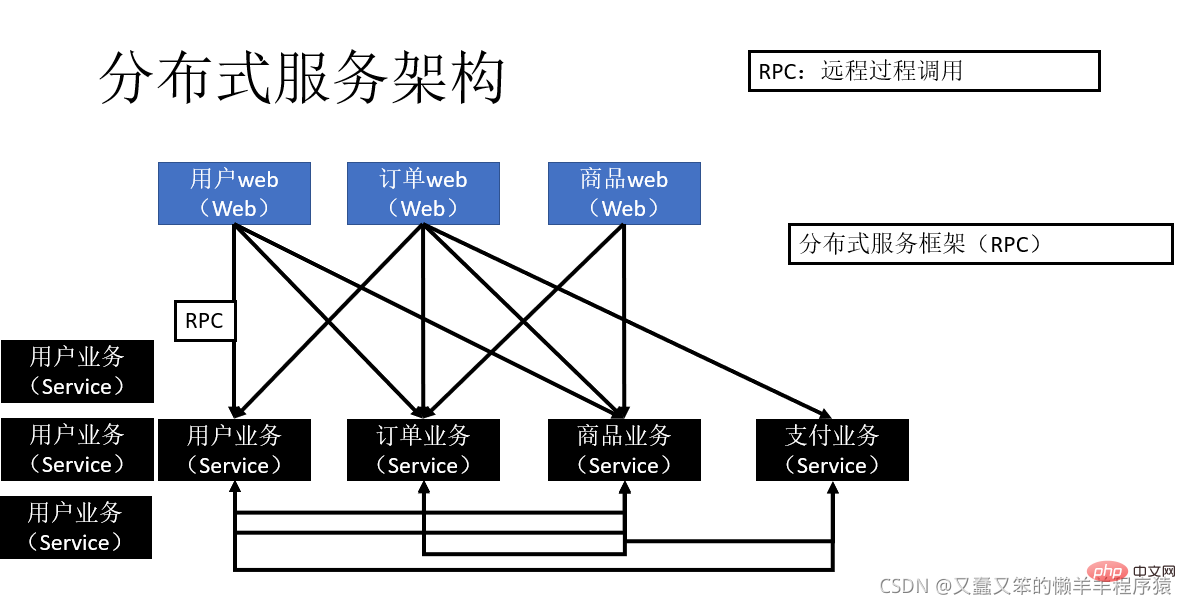
When there are more and more services, service URL configuration management becomes It is very difficult. The single-point pressure on the hardware load balancer is also increasing. With the registration center, unified management of services can be achieved, soft load balancing can be achieved, and hardware costs can be reduced. The following is a schematic diagram of the registration center:
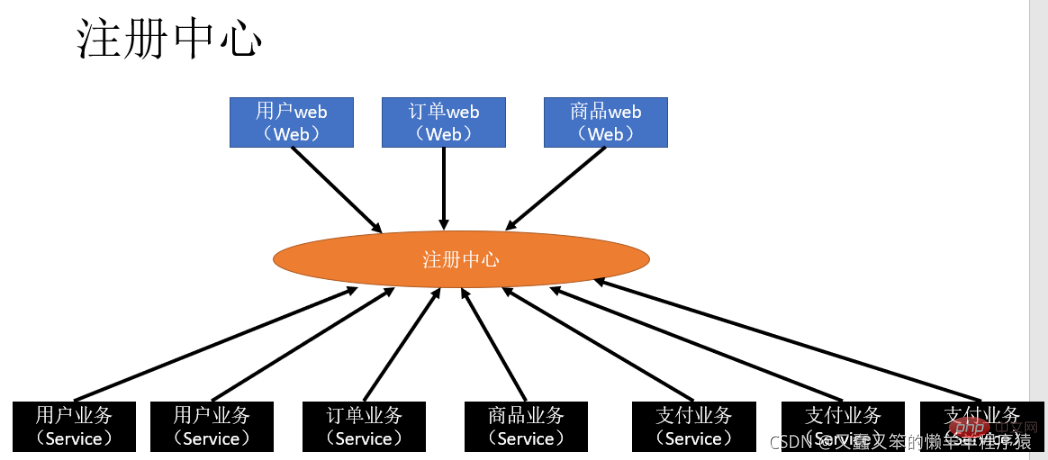
Monitor
is a monitoring center that counts the number of service calls and call time. Faced with many services, refined monitoring and convenient operation and maintenance are indispensable. , which is very important for later maintenance.
Container
is the container in which the service runs.
Architecture

The roles played by each node in the diagram have been introduced. The following is the calling relationship between each node:
Container The service container is responsible for starting, loading and running
ProviderService providerProviderWhen the service provider starts, it needs to expose itself. The remote server can discover and register the services it provides with the Registry registration center.
ConsumerWhen the service consumer starts, it registers with the Registry registration center. Subscribing to the services required
RegistryThe registration center returns the service provider list to the consumer. At the same time, if changes occur, the registration center will push real-time data to the consumer based on the long connection
When a service consumer needs to call a remote service, it will select a provider server from the provider's address list based on the load balancing algorithm to call. If the call fails, the call will be retried based on the cluster fault tolerance strategy
Service consumers and providers will count the number of calls and call times in memory, and then send the data to MonitorMonitoring Center
High Availability
# through scheduled tasks- ##After the monitoring center goes down, it will not affect the service, but some statistical data will be lost.
- After registering the center cluster, after any one goes down, the service will be lost. Automatically switch to other registration centers
- When all registration centers are down, service providers and consumers can still communicate through the local cache that records each other's information, but if When one party makes a change, the other party cannot detect it.
- The service provider is stateless. If any server goes down, it will not affect the use. There will be other service providers to provide services
- When all service providers are down, the service consumer cannot use it normally and will reconnect indefinitely waiting for the service provider to reconnect and recover
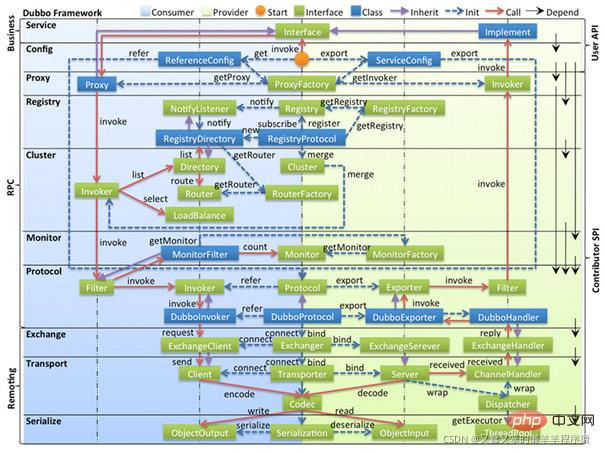
Service, the business layer, which is the business logic layer in daily development
Config, configuration layer, external configuration interface, centered on ServiceConfig and ReferenceConfig, can directly initialize the configuration class, or can be generated through Spring parsing the configuration Configuration class
Proxy, service proxy layer, service interface transparent proxy, generate service client Stub and client Skeleton, responsible for remote Call and return results
Registry, the registration center layer, encapsulates the registration and discovery of service addresses, with the service URL as the center, and the extended interface is RegistryFactory, Registry, RegistryService
Cluster Routing and cluster fault tolerance layer encapsulates the routing, load balancing and cluster fault tolerance of multiple providers, and bridges the registration center , Responsible for selecting specific nodes to call through load balancing, processing special call requests and taking fault-tolerance measures for remote call failures
Monitor, monitoring layer, responsible for monitoring and counting the number of RPC calls and call time
Portocol, the remote call layer, mainly encapsulates the RPC remote call method
Exchange, the information exchange layer, used to encapsulate the request response model
Transport, network transport layer, abstract network transmission unified interface, Mina and Netty are available
Serialize, the serialization layer, serializes data into a binary stream for transmission, and can also deserialize and receive data
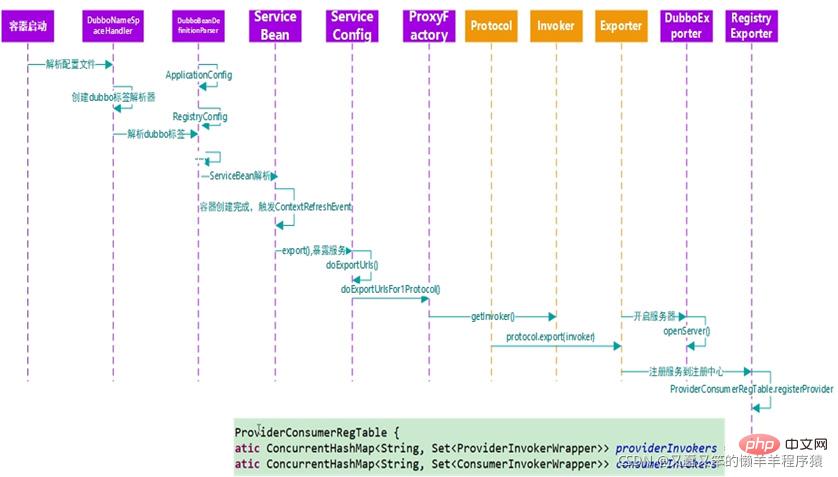
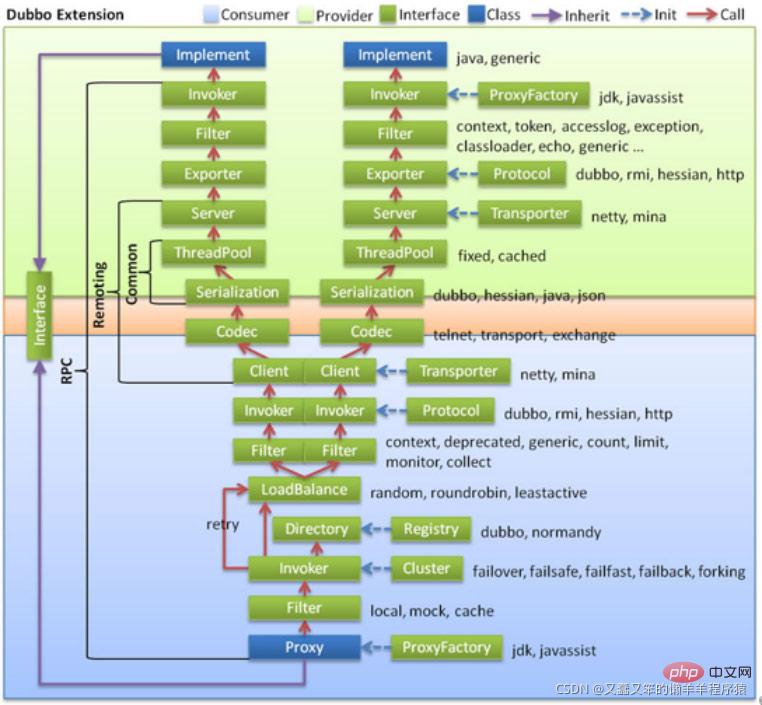
ProxyFactory Generates a Proxy proxy class. Proxy holds an Invoker executable object. After calling invoke, you need to pass ClusterGet the list of all callable remote service Invoker from Directory. If certain routing rules are configured, you need to filter the Invoker list again.
LoadBalance, and some data statistics need to be done through Filter, and then the data will be saved and sent to Monitor# regularly. ##. Next, use
for data transmission, and generally use Netty for transmission. Transmission requires protocol construction through the
interface, and then serialization through Serialization, and finally the serialized binary stream is sent to the corresponding service provider By. <p>After receiving the binary stream, the service provider will also perform Codec protocol processing, and then deserialize (the processing here is symmetrical to the processing before transmission) and then put the request into the thread pool for processing. The thread will find the corresponding <code>Exporter according to the request, then filter it layer by layer through Filter to obtain the Invoker, and finally call the corresponding implementation class and return the result in the original way.
The above is the detailed content of Principle and example analysis of Java-based distributed service framework Dubbo. For more information, please follow other related articles on the PHP Chinese website!

Hot AI Tools

Undresser.AI Undress
AI-powered app for creating realistic nude photos

AI Clothes Remover
Online AI tool for removing clothes from photos.

Undress AI Tool
Undress images for free

Clothoff.io
AI clothes remover

AI Hentai Generator
Generate AI Hentai for free.

Hot Article

Hot Tools

Notepad++7.3.1
Easy-to-use and free code editor

SublimeText3 Chinese version
Chinese version, very easy to use

Zend Studio 13.0.1
Powerful PHP integrated development environment

Dreamweaver CS6
Visual web development tools

SublimeText3 Mac version
God-level code editing software (SublimeText3)

Hot Topics
 Square Root in Java
Aug 30, 2024 pm 04:26 PM
Square Root in Java
Aug 30, 2024 pm 04:26 PM
Guide to Square Root in Java. Here we discuss how Square Root works in Java with example and its code implementation respectively.
 Perfect Number in Java
Aug 30, 2024 pm 04:28 PM
Perfect Number in Java
Aug 30, 2024 pm 04:28 PM
Guide to Perfect Number in Java. Here we discuss the Definition, How to check Perfect number in Java?, examples with code implementation.
 Random Number Generator in Java
Aug 30, 2024 pm 04:27 PM
Random Number Generator in Java
Aug 30, 2024 pm 04:27 PM
Guide to Random Number Generator in Java. Here we discuss Functions in Java with examples and two different Generators with ther examples.
 Armstrong Number in Java
Aug 30, 2024 pm 04:26 PM
Armstrong Number in Java
Aug 30, 2024 pm 04:26 PM
Guide to the Armstrong Number in Java. Here we discuss an introduction to Armstrong's number in java along with some of the code.
 Weka in Java
Aug 30, 2024 pm 04:28 PM
Weka in Java
Aug 30, 2024 pm 04:28 PM
Guide to Weka in Java. Here we discuss the Introduction, how to use weka java, the type of platform, and advantages with examples.
 Smith Number in Java
Aug 30, 2024 pm 04:28 PM
Smith Number in Java
Aug 30, 2024 pm 04:28 PM
Guide to Smith Number in Java. Here we discuss the Definition, How to check smith number in Java? example with code implementation.
 Java Spring Interview Questions
Aug 30, 2024 pm 04:29 PM
Java Spring Interview Questions
Aug 30, 2024 pm 04:29 PM
In this article, we have kept the most asked Java Spring Interview Questions with their detailed answers. So that you can crack the interview.
 Break or return from Java 8 stream forEach?
Feb 07, 2025 pm 12:09 PM
Break or return from Java 8 stream forEach?
Feb 07, 2025 pm 12:09 PM
Java 8 introduces the Stream API, providing a powerful and expressive way to process data collections. However, a common question when using Stream is: How to break or return from a forEach operation? Traditional loops allow for early interruption or return, but Stream's forEach method does not directly support this method. This article will explain the reasons and explore alternative methods for implementing premature termination in Stream processing systems. Further reading: Java Stream API improvements Understand Stream forEach The forEach method is a terminal operation that performs one operation on each element in the Stream. Its design intention is





